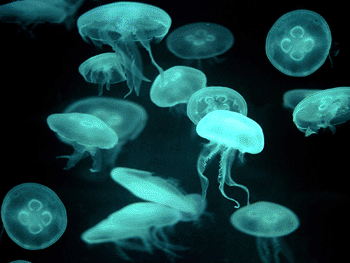Benchtop Technology Designed for Marking, Selecting Cells
By LabMedica International staff writers
Posted on 22 Jan 2013
Chemists have found a simpler way to perform one of the most essential chores in molecular biology. Their new method allows scientists to add a marker to specific cells, so that these cells may be easily located and/or chosen from a larger cell population. Posted on 22 Jan 2013
The technique, which is described in January 2012 in the chemistry journal Angewandte Chemie International Edition, makes use of the tight binding of two proteins that are inexpensively available but are not found in human or other mammalian cells. Therefore, it has advantages over existing cell-marking techniques.

Image: The most common jellyfish protein used in lab research glows green when illuminated with UV light (Photo courtesy of NA/TSRI).
“This new technique is cheap, easy, and sensitive,” said the Scripps Research Institute (TSRI; La Jolla, CA, USA) Prof. Richard A. Lerner, who is the senior author of the new report. “The method should be useful in a variety of applications that require separating out certain types of cells.”
The best-known cell marker currently used is green fluorescent protein (GFP), a protein derived from a jellyfish that emits a characteristic green light when illuminated by specific light wavelengths. When scientists need to add a new gene to cells, for example, to produce a therapeutic protein, they frequently construct a genetic sequence that also includes the GFP gene. Consequently, the cells that effectively produce the new protein will also generate GFP, whose fluorescence allows these cells to be identified and even sorted out from a larger population.
However, fluorescence-based cell sorting is comparatively costly and cumbersome. Alternative cell-marking techniques use marker molecules to which metals or antibodies will bind tightly, but these tend to have annoying side effects on the cells that they mark. Prof. Lerner’s team, led by first author Yingjie Peng, a postdoctoral fellow, set out to devise a better approach.
The new method exploits a special characteristic of chitinase enzymes, which evolved degrade chitin—a rugged, sugar-derived substance found, for example, in squid beaks, crab shells, and the cell walls of fungi. In addition to a main chitin-breaking domain, chitinases have another active structure, a chitin-binding domain (ChBD). “It makes a super-strong bond with chitin,” said Dr. Peng. Recently, scientists have begun to use this high-affinity binding of ChBD and chitin as a marker system, typically for selecting ChBD-tagged proteins in a lab dish. The new method uses ChBD to mark and select cells.
A new gene, in the method, can be added to cells within a larger DNA vector that also includes the genetic sequences for ChBD and GFP. The ChBD molecule will be produced in such a way that it ends up being held on the outer surface of its host cell’s plasma membrane—and the GFP molecule will sit just inside the membrane. The GFP acts as a visual beacon, while the ChBD serves as a handy gripping point for cell selection.
The scientists, after exposing a culture of test cells to this research ChBD-containing vector, were able to visualize, by way of the GFP tags, which cells were expressing them, and was able to pick them out easily, with high sensitivity, utilizing magnetic beads coated with chitin. “This is a relatively easy benchtop method,” Dr. Peng said. Significantly, these selected cells could generate progeny cells that appeared healthy.
Because the ChBD marker, in the vector, is produced in a manner that secures it to a cell’s membrane, it also can serve as a vital application for selecting just the membrane fraction of a sample of cellular material. Dr. Peng and his colleagues showed this using chitin beads to rapidly isolate a pure fraction of membrane material from ChBD-marked test cells. Cellulase enzymes, which degrade the common plant compound cellulose, also have a high-affinity cellulase-binding domain, which can be employed in the same way as the ChBD.
The scientists expect that the new cell-marking method will help to streamline another major molecular biology technique, which was developed by the Lerner laboratory in parallel with the group of Sir Gregory Winter at the Laboratory of Molecular Biology (Cambridge, UK). This technique allows scientists to produce very large and diverse libraries of antibody arms, and to sift through them, or “pan”—in the way miners pan for gold nuggets—for those that might be of use, for example in therapies. ChBD-based markers should be beneficial in boosting the effectiveness of this panning process, according to Dr. Peng.
The investigators are also assessing the potential use of ChBD-based cell marking in living animals, for example, to monitor the outcome of selected cell types throughout an animal’s lifecycle.
Related Links:
Scripps Research Institute














